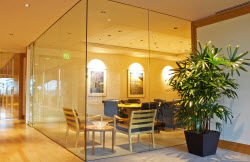
One of my clients is remodeling their offices. Employees have to walk through construction everyday, and it’s having a chilling effect on morale. When deciding how to manage the construction process, my client underestimated the powerful impact that surroundings have on performance.
As humans, we’re drawn to beauty. We’re instinctively attracted to interesting and inviting aesthetics. Exhibit A, a large part of Apple’s  success was Steve Jobs’ insistence on a clean aesthetic. He knew that form was equally as important as function. It’s not just in their products; the Apple aesthetic is intentional in their stores, and their corporate offices.
success was Steve Jobs’ insistence on a clean aesthetic. He knew that form was equally as important as function. It’s not just in their products; the Apple aesthetic is intentional in their stores, and their corporate offices.
Leaders know that making your products and customer spaces beautiful is essential to business. But many organizations miss the mark because they don’t carry the concept through to the employee’s domain.
Walk into the back of most retail establishments, a grocery store, restaurant or hotel, and you’ll see a huge change the moment you cross the threshold from the front of the house to the back. The areas where the employees live have crummy flooring, cheap lighting, and broken furniture. Yet these employees are still supposed to act like gracious hosts.
In non-retail businesses it’s often worse. The corporate website and brochures are beautiful, but the offices look horrible. Employees  work surrounded by grungy cubicles and cardboard file boxes stacked in the hall.
work surrounded by grungy cubicles and cardboard file boxes stacked in the hall.
I’m not making the case for mahogany desks or oriental rugs, but if your workplace is dull, or even worse, a mess, people aren’t going to perform at a peak level.
A recent experience with my family demonstrates the powerful effect that environment has on attitude.
We’re remodeling our bathroom. The contractor started the day I left for a business trip. I left a family who loved each other and enjoyed being in our home. After a week of living with bags of grout in the hall, and a toilet on the landing, I returned to cranky people who didn’t seem to like each other too much.
It was almost as if they had become different people. And in many ways they had, their attitudes had done a 180. Here’s the kicker: the entire mess was confined to three rooms, our bathroom, our bedroom, and the upstairs hall. Nothing was in the common areas. Simply having to walk through chaos each morning had a horrible effect on everyone.
My daughter got so sick of it that she did the unthinkable; she cleaned her room. She said, “I got so frustrated, I cleaned five bags of trash from my room.” She hadn’t realized until that moment how much of her confidence came from having beauty and calm in her everyday environment. It was a powerful lesson.
When things look chaotic, people are more likely to act chaotic. My daughter got frustrated enough to create an oasis of peace and beauty in her room. But it was only because she knew she was missing it. If she had never experienced a calm beautiful environment, she wouldn’t have felt its absence.
Our minds, and our actions respond to our surroundings. Much of it is subconscious. When you’re surrounded by beauty, you’re happier and more confident.
Look at your own workspace. Does it look the way you want to feel? If you’re a leader, ask yourself, have I provided my team with a space that reflects the way I want them to treat our customers?
Humans respond to beauty, even at work.